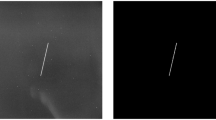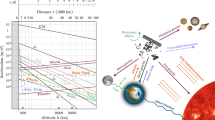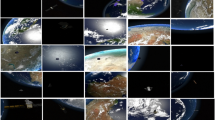Abstract
Applications of artificial intelligence have been gaining extraordinary traction in recent years across innumerable domains. These novel approaches and technological leaps permit leveraging profound quantities of data in a manner from which to elucidate and ease the modeling of arduous physical phenomena. ExoAnalytic collects over 500,000 resident space object images nightly with an arsenal of over 300 autonomous sensors; extending the autonomy of collection to data curation, anomaly detection, and notification is of paramount importance if elusive events are desired to be captured and classified. Efforts begin with rigorous image annotation of observed glints, streaking stars, and resident space objects with plumes from debris shedding events. Preliminary results permitted the successful classification of observed debris generating events from AMC-9, Telkom-1, and Intelsat-29e. After initial proof-of-concept, these events are incorporated into the training pipeline in order to characterize potentially unknown debris generating or anomalous events in future observations. The inclusion of a visual tracking system aides in reducing false alarms by roughly 30%. Future efforts include applications on both historical datamining as well as real-time indications and warnings for satellite analysts in their daily operations while maintaining a low probability of false alarm through detection and tracking algorithm refinement.



















Similar content being viewed by others
References
Pelletier, C., Webb, G.I.: Temporal convolutional neural network for the classification of satellite image time series. Remote Sens. 11(5), 523 (2019). https://doi.org/10.3390/rs11050523
Goodfellow, I.J., Pouget-Abadie, J., Mirza, M., Xu, B., Warde-Farley, D., Ozair, S., Courville, A., Bengio, Y. Generative Adversarial Nets. Proceedings of the 27th International Conference on Neural Information Processing Systems, No. 2, pp. 2672–2680 (2014)
Li, Y.: Deep Reinforcement Learning. arXiv. Vol. 1810.06339v1 [cs.LG]. (2018)
Little, B.D., Frueh, C.: SSA Sensor Tasking: Comparison of Machine Learning with Classical Optimization Methods. Proceedings of the Advanced Maui Optical and Space Surveillance Technologies Conference. pp. 1–17 (2018)
Temple, D., Poole, M., Camp, M.: Network Enabled - Unresolved Residual Analysis and Learning. Proc. Adv. Maui Optical Space Surveill. Technol. Conf., 118–122 (2017)
Temple, D.: Synthetic Heterogenous Anomaly and Maneuver – Neural Network Event Winnowing System. Proc Adv. Maui Optical Space Surveill. Technol. Conf., 87–91 (2018)
Zoph, B., Le, Q. V.: Neural Architecture Search with Reinforcement Learning. arXiv. Vol. 1611.01578v2 [cs.LG] (2017)
Furfaro, R., Linares, R., Reddy, V.: Shape identification of space objects via light curve inversion using deep learning models. Proceedings of the Advanced Maui Optical and Space Surveillance Technologies Conference. (2019)
Fletcher, J., McQuaid, I., Thomas, P., Sanders, J., Martin, Greg: Feature-Based Satellite Detection Using Convolutional Neural Networks. Proceedings of the Advanced Maui Optical and Space Surveillance Technologies Conference. (2019)
Redmon, J., Farhadi, A.: Yolov3: An incremental improvement. arXiv. Vol. 1804.02767 [cs.CV] (2018)
Reddie, PJ. Darknet: Open source neural networks in c. http://pjreddie.com/darknet/, 2013–2016. (2016)
He, K., Zhang, X., Ren, S., Sun, J.: Deep Residual Learning for Image Recognition. IEEE Conference on Computer Vision and Pattern Recognition. pp. 770–778 (2016)
Ioffe, S., Szegedy, C.: Batch Normalization: Accelerating Deep Network Training by Reducing Internal Covariate Shift. Proceedings of the 32nd International Conference on International Conference on Machine Learning. No. 37 pp. 448–456 (2015)
Wojke, N., Dietrich, B. A. and Dietrich, P.: Simple Online and Realtime Tracking with a Deep Association Metric. IEEE Int. Conf. Image Process., 3645–3649 (2017)
Berger, E. It looks like yet another satellite is breaking apart at GEO. Arstechnica.comhttps://arstechnica.com/science/2017/08/it-looks-like-yet-another-satellite-is-breaking-apart-at-geo/ (2017). Accessed July 2019
Shaoqing, R., Kaiming, H., et al.: Faster R-CNN: Towards Real-Time Object Detection with Region Proposal Networks. IEEE Trans Pattern Anal Mach Intell Trans Pattern Anal Mach Intell. 39(6), 1137–1149 (2017)
Author information
Authors and Affiliations
Corresponding author
Ethics declarations
Conflict of Interest
The authors do not have any competing or conflicts of interest pertaining to this work.
Additional information
Publisher’s Note
Springer Nature remains neutral with regard to jurisdictional claims in published maps and institutional affiliations.
Rights and permissions
About this article
Cite this article
Temple, D. Real-Time Plume Detection and Segmentation Using Neural Networks. J Astronaut Sci 67, 1793–1810 (2020). https://doi.org/10.1007/s40295-020-00237-w
Accepted:
Published:
Issue Date:
DOI: https://doi.org/10.1007/s40295-020-00237-w




